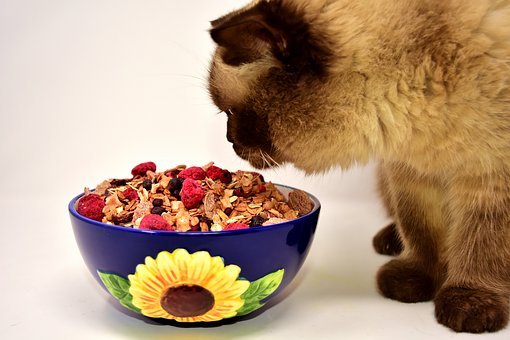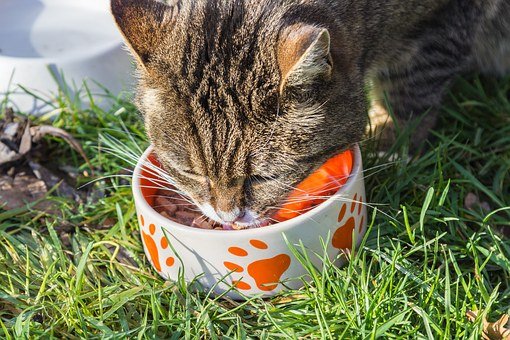Is a Raw Food Diet Good for Cats
Anecdotal evidence suggests that some cats thrive on raw diets, but only if owners take steps to mitigate the risks associated with raw feeding.
Many store-bought cat foods are overly weighted toward carbohydrates, which can cause a variety of health problems in cats. Furthermore, their protein sources are often poor quality and many contain artificial ingredients. These issues, as well as fears sparked by various pet food recalls, have convinced many cat owners to seek alternatives such as raw diets.
The Benefits of Raw Diets for Cats
Though still controversial, raw diets are gaining popularity as more and more people choose to make natural cat food at home or purchase commercially available raw food diets. Anecdotal evidence indicates that many cats that are fed nutritionally complete raw diets may experience benefits, including:
- Weight loss
- Glossier coat
- Reduced stool volume, frequency, and odour
- Healthier teeth and better breath
- Overall improved health
There are a number of risks associated with raw diets, particularly those prepared at home, which is why many veterinarians recommend against these diets. However, raw diet proponents argue that the benefits outweigh the risks, provided that owners take steps to minimize those risks.
Raw Diets and Parasite Infestation
A raw diet is certainly closer to what a cat would eat in the wild, but cats in the wild regularly suffer from parasite infestations. The USDA states that many parasites can be killed by freezing, but that 100% surety can only be achieved with rigidly controlled conditions. An online search turns up a broad range of freezing recommendations to kill parasites, ranging from a couple of days to several weeks, depending on the type of meat.
Although freezing won't guarantee the elimination of all parasites, adding this step before thawing and preparing the food significantly reduces the risk. As for bacteria that can cause illness, they are inactivated but not killed by freezing. When the meat is thawed, these bacteria will again be capable of causing illness.
Raw Diets and Salmonella
A study of raw meat samples from Washington, DC, grocery stores found that 20% were contaminated with salmonella bacteria in 2001 (White et al., 2001). However, according to the University of Wisconsin-Madison School of Veterinary Medicine, USDA data indicates that this rate has been dropping, with just 3.6% of meats contaminated in 2003. Although many pets that consume salmonella bacteria may simply become carriers (potentially spreading the disease to humans through feces and saliva), some cats and dogs do become sick with the illness.
Salmonella infection is more common in humans than cats and dogs. There are an estimated 1.4 million cases per year, with more severe cases requiring hospitalization, and a small percentage being fatal (University of Wisconsin-Madison School of Veterinary Medicine, n.d.). Symptoms of salmonella illness may include some or all of the following:
- Abdominal pain
- Appetite loss
- Diarrhea
- Fever
- Headache
- Lethargy
- Nausea
- Vomiting
Salmonella bacteria are particularly common in poultry, which is one of the best sources of protein for raw-fed cats. Although many proponents of raw feeding argue that cats are less susceptible to salmonella poisoning due to aspects of their physiology, at least two raw-fed cats have died of salmonella poisoning thus far, and there are other bacteria in raw meats that can cause illness in cats as well.
Owners who wish to raw feed their cats can reduce the risk of bacterial contamination by doing the following:
- Purchase meat directly from reputable sources rather than supermarkets to obtain fresher cuts.
- Thaw meat in the fridge rather than on the counter.
- Use whole pieces of meat and rinse them with water before serving to remove as much surface bacteria as possible.
- If you want to use ground meat, grind it yourself at home under sanitary conditions – don't purchase it from a supermarket because it may have bacteria ground throughout the package.
- If making batches of food, immediately freeze portions that won't be served right away.
- Don't leave food out for long after serving.
- Wash cat dishes and utensils in hot soapy water after each feeding, and do the same for any containers used to store the cat food once they have been emptied.
While these measures reduce the risk, they don't eliminate it entirely. A safer alternative to providing totally raw food is to quickly cook just the surfaces of whole pieces of meat to kill any bacteria adhering to the outside while leaving the centers raw.
Raw Diets and the Dangers of Bones
Because the meats used in pet foods are normally deboned, pet food manufacturers usually add bone meal to replace the calcium and other lost nutrients. Several different strategies are used to provide these nutrients in raw diets, including feeding whole prey, grinding bones in with meat, adding bone meal powder to the food, and providing meaty bones to chew (some believe that this also promotes dental health).
Fine-ground bone and bone meal powder are the safest options, as bigger pieces of bone may splinter and get stuck in a pet's mouth or digestive tract, and may even puncture the gastrointestinal tract (raw bones are less likely to splinter than cooked bones, but there is still a risk). Raw-feeding proponents argue that cats eat bones in the wild, but a cat's natural prey are very small animals – typically mice and little birds – whereas the bones fed in raw diets often come from much bigger creatures. Cats wouldn't typically be dealing with such large bones, so they may break their teeth on them.
Those planning raw diets should also keep in mind that consuming too much bone in relation to the amount of meat may trigger constipation and other health problems. Owners must be careful to ensure an appropriate balance of bone to meat in the diet.
Raw Diets and Malnutrition
Raw feeding is a far more complex process than simply dumping chunks of raw meat in a bowl. Creating nutritionally complete cat food requires compensating for differences between meat available for purchase and natural prey, and modifying or supplementing as necessary. It also requires customizing the diet to address a cat's medical needs because cats with health issues such as kidney disease or pancreatitis may require special dietary modifications.
If you want to feed your cat a raw diet but lack the time and resources to research, plan, and prepare nutritionally complete and raw cat food, there are a number of raw diets commercially available. If purchasing a commercial diet, avoid those with too many vegetables or grains, which cats would not eat in the wild. Veterinarian Lisa Pierson recommends Feline's Pride, which is free of grains and vegetables, and Nature's Variety, which contains just 5% plant-based ingredients.
It's very difficult to provide a balanced diet for cats. Those who fail to do the research and plan the diet properly, preferably in collaboration with a veterinarian who is sympathetic to raw feeding, may put their cats at risk for serious health problems or even death.
Additional Risks
If you are considering raw feeding, there are additional risks to keep in mind, such as toxins in fish, digestive upsets that can be triggered by dairy products, the dangers associated with feeding raw eggs, and the fact that many foods that are good for humans are toxic to cats.
This article is provided for informational purposes only. It is not intended as a substitute for veterinary consultation. Health and nutritional concerns should be referred to a qualified veterinarian.
References:
Centers for Disease Control and Prevention, "Parasites - Trichinellosis (also known as Trichinosis)," CDC.gov https://www.cdc.gov/parasites/trichinellosis/index.html
Hines, R., DVM, PhD, "Home Cooked Pet Diets, Home Made Recipes and Pet Nutrition," 2ndChance.info https://www.2ndchance.info/homemadediets.htm
Lieber, A., "Raw Meat Debate: Should You Feed It to Your Cat?" PetPlace.com https://www.petplace.com/article/cats/pet-health/raw-meat-debate-should-you-feed-it-to-your-cat/
Messonnier, S., DVM, "Homemade Diets for Pets," SPCA International, SPCAI.org https://www.spcai.org/get-involved/learn/animal-advice/homemade-diets-pets/


Please Upvote➜https://steemit.com/christianity/@bible.com/verse-of-the-day-revelation-21-8-niv
thanks for sharing the information about the cats
Well, cats ARE little carnivores, and ours certainly bring us occasional "presents" in the form of rats and birds. And that's not "for fun" but because their natures tell them it's "food." Maybe the "secret" here is to keep everything fresh, and to know where you are sourcing the meats for your cat.
=^..^=